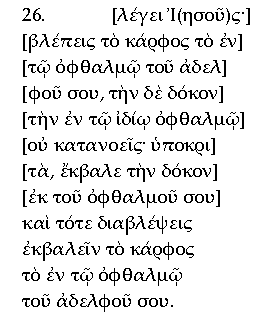Visitor Comments
You must practice before you may rightly preach.
- Martin
Once one has discoverd how to integrate one's innate adult and child selves, then one can teach others how to do so.
- Rodney
He is saying--you see the faults in others, but you do not judge yourself. Once you realize your own faults, and correct them, then you can judge others fairly as well.
- Holly
Attend to your own defects. Criticism of those in others is not productive. An essential technical exhortation
- Thief37
See saying 5: recognize what is in front of you = remove the beam from your eye. You have to be able to see what is hidden before you can help other people do so (remove the splinter from your brother's eye).
- stef
If you do not take care of yourself (in every sense), you will not be fit to take care of others.
- pm
|
Scholarly Quotes
Marvin Meyer quotes 'Arakin 16b in the Babylonian Talmud for a comparable story: "It was taught: Rabbi Tarfon said, 'I wonder whether there is a person of this generation who accepts admonition? If someone says to him, "Remove the chip from between your eyes (or, eye teeth)," he would say to him, "Remove the beam from between your eyes (or, eye teeth)."'" (The Gospel of Thomas: The Hidden Sayings of Jesus, p. 81)
Robert M. Grant and David Noel Freedman write: "The saying is very slightly modified from a saying related in Matthew 7:3, 5 and in Luke 6:41-42. In the Coptic version it leads without a break into Saying 28, and thus seems to imply that the beam in the Gnostic's eye is his absolute rejection of fasting and Sabbath observance. He ought to explain the spiritual meaning of these actions to his Jewish, or Jewish-Christian, brothers, or potential brothers." (The Secret Sayings of Jesus, p. 146)
R. McL. Wilson writes: "Fitzmyer notes some differences between the Greek and the Coptic, but thinks what is preserved of the Greek is nearer Luke (vi. 42) than Matthew. This passage poses a somewhat delicate problem for the investigator: Is this merely an abbreviation of the Synoptic saying or has elaboration taken place in the Synoptic tradition as early as the hypothetical Q? Both Matthew and Luke put the first sentence in the form of a question, and both add a further question before the final 'Thou hypocrite! first cast out the beam. . . .' The Coptic here has a temporal clause instead of the imperative, but as Fitzmyer notes the Greek appears to have corresponded to that of the canonical Gospels. This raises once against the question of the relation between the Coptic Thomas and the Oxyrhynchus fragments, and in this case it is difficult to see why the change should have been made. As it is, the version in Thomas is terse and to the point, and a case might be made out for expansion in the canonical tradition. But a decision here is extremely difficult." (Studies in the Gospel of Thomas, p. 58)
Funk and Hoover write: "Thomas' version of this humorous comparison is simpler than the form found in Q, which suggests that the latter has been expanded. . . . Thomas does not use the word 'phony' - someone who pretends to be someone he or she isn't - so this element may be secondary. The Q version is also redundant (lines 4-5 in the Q version repeat lines 1-2)." (The Five Gospels, p. 488)
Gerd Ludemann writes: "The key words 'brother' and 'eye' link Logia 26 and 25. Logion 26 corresponds to Q (Matt. 7.3-5/Luke 6.41-42) and as the simpler construction may also represent the earliest stage. But it is also conceivable that Thomas has simplified an earlier saying, the centre of which was reproof of the brother, and put self-correction at the centre." (Jesus After 2000 Years, p. 603)
|

